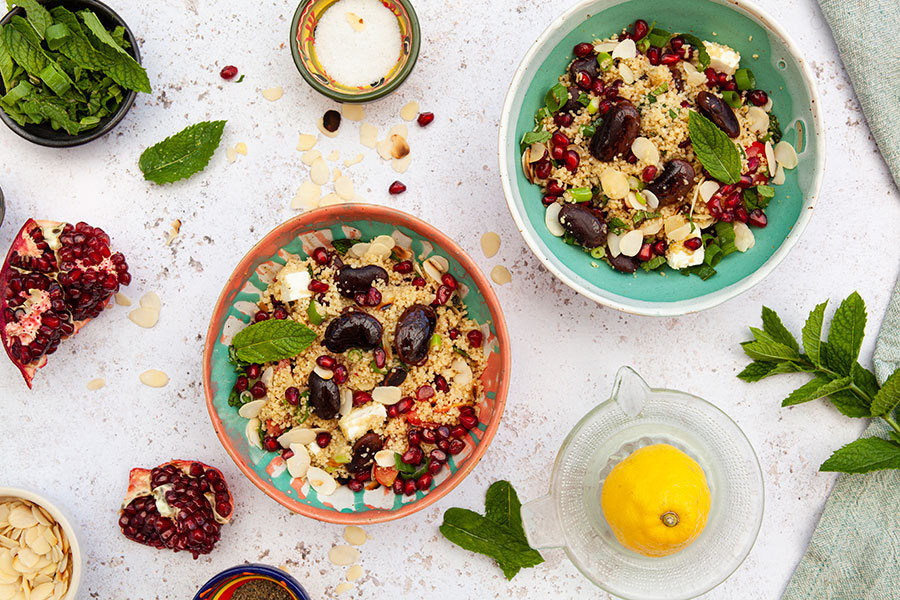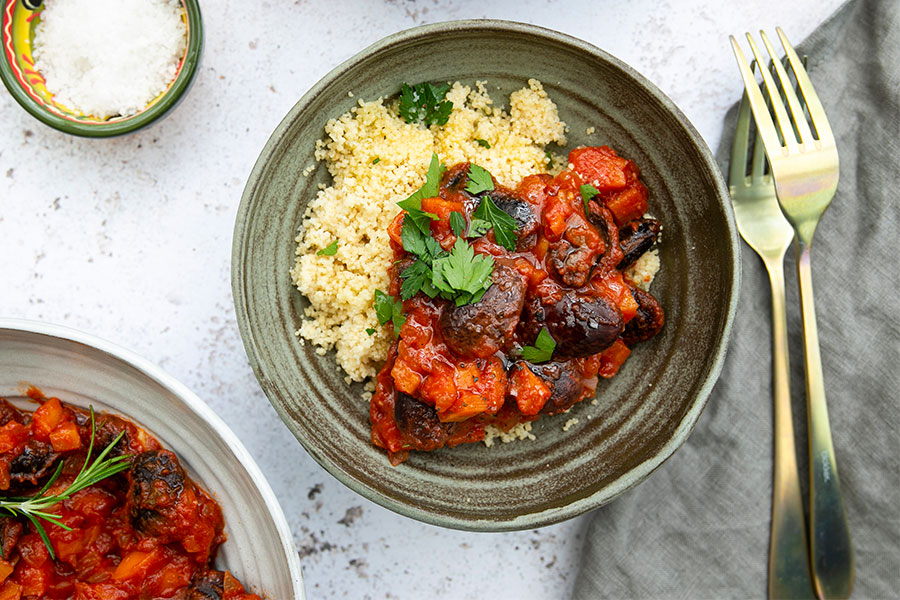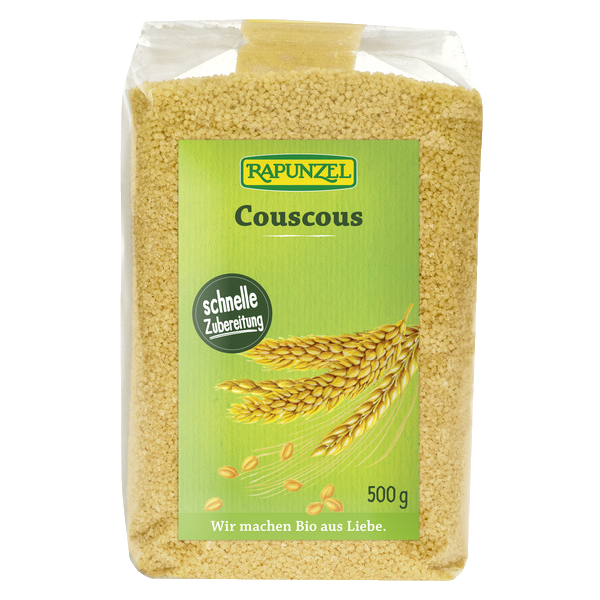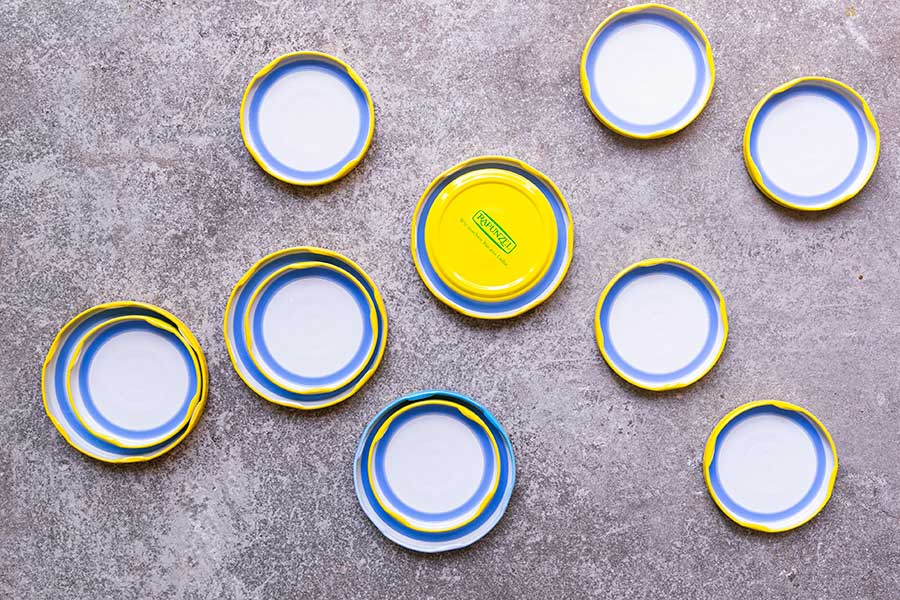This traditional ingredient of the Northern African dishes made from durum wheat semolina is very versatile. Quick preparation in only 5 minutes.
Ingredients
DURUM WHEAT* pre-cooked
* = ingredients from organic farming
** = from biodynamic agriculture
DURUM WHEAT* pre-cooked
* = ingredients from organic farming
** = from biodynamic agriculture
Characteristics
cultivated in Europe, packed by Rapunzel
Usage
Ideal for fillings or as a side dish, in combination with legumes such as chickpeas, in vegetables dishes and salads. Also delicious with sweet ingredients such as figs, dates or raisins.
Preparation Instructions
Pour 300 ml boiling water over 250 g couscous. Add salt, cover and let soak for 5 minutes. Use a fork to fluff it up.
cultivated in Europe, packed by Rapunzel
Usage
Ideal for fillings or as a side dish, in combination with legumes such as chickpeas, in vegetables dishes and salads. Also delicious with sweet ingredients such as figs, dates or raisins.
Preparation Instructions
Pour 300 ml boiling water over 250 g couscous. Add salt, cover and let soak for 5 minutes. Use a fork to fluff it up.
Additional information
Preparation
The durum wheat semolina is grated into small pieces. It is then cooked, dried, sifted and packed.
Produced in
Italy
Country of origin
italian agriculture
Origin of the main ingredients
Italy
Quality
EU Bio-Logo
Storage advice
Store in a cool and dry place.
Legal name of the food product
Couscous
| Calorific value | 1508 kJ / 356 kcal | |
| Fat | 2,00 g | |
| of which saturates | 0,30 g | |
| Carbohydrates | 71,00 g | |
| Sugar | 3,00 g | |
| Dietary fiber | 5,0 g | |
| Protein | 11,00 g | |
| Salt | 0,010 g |
Allergens
| Eggs and products thereof | not contained | |
| Peanuts and products thereof | not contained | |
| Fish and products thereof | not contained | |
| Cereals containing gluten or cereal products | contained | |
| Crustaceans and products thereof | not contained | |
| Milk and products thereof including lactose | not contained | |
| Lupins and products thereof | not contained | |
| Nuts and products thereof | not contained | |
| Celery and products thereof | not contained | |
| Mustard and products thereof | Possible in traces | |
| Sesame seeds and products thereof | not contained | |
| Soy and products thereof | Possible in traces | |
| Sulfur dioxide or sulfites (more than 10mg/kg or 10 mg/l SO2) |
no | |
| Molluscs and products thereof | not contained |
Mit großer Sorgfalt pflegen wir unsere Online-Produktdatenbank. Dennoch können wir vereinzelte Fehler nicht ausschließen. Daher bitten wir Sie, diese Angaben immer mit dem Etikett des jeweiligen Produktes zu vergleichen. Sollten Ihnen Unstimmigkeiten auffallen, sind wir dankbar für einen Hinweis an kundenservice@rapunzel.de.
FAQ about Couscous
In the case of organic cereal products, despite intensive labour input during cultivation and intensive cleaning measures, the presence of foreign seeds cannot be completely ruled out, nor can products with optical deviations.
The colour of a grain or seed in cereals, legumes and oilseeds varies from harvest to harvest due to many factors such as soil conditions, climate and weather. Since we work with many small farmers from different growing areas, the products are exposed to different influences that lead to natural colour variations. Extreme weather conditions can cause such severe optical changes that it is no longer possible to sort out grains and seeds at a reasonable economic cost. However, as we value long-term economic cooperation with the small farmers, we also buy the harvest in difficult years and try to use it in the best possible way.
No herbicides are used in the organic sector. Thus, in some cases, even weed seeds of the same weight or size are very difficult to remove from the product.
Of course, these products are subject to particularly intensive controls by us and are only traded if it is a purely visual problem, without any effects in terms of taste and nutritional quality.
We are trying to further improve our possibilities for mechanical cleaning, but this is sometimes very difficult due to physical limits (e.g., 0.5 mm amaranth).
mehr erfahren
mehr erfahren
mehr erfahren
mehr erfahren
Gluten, also known as gluten protein, is a group of certain proteins found in cereal grains such as wheat, rye, barley, and oats.
The gluten content is of decisive importance for the baking properties of a flour. Gluten protein binds up to three times its weight in water when it becomes moist. In the process, it develops rubber-like, elastic properties. Like a skeleton, the gluten threads run through the bread dough and ensure that a fine-pored, loose dough forms. The quantitatively and qualitatively highest gluten is provided by wheat, to which it also owes its excellent baking properties.
Some people are allergic to this protein due to a metabolic disorder. With sprue or coeliac disease, the medical names for this intolerance, a lifelong gluten intolerance remains. Coeliac disease and sprue are chronic diseases of the small intestine that manifest in childhood or do not appear until adulthood. Since the organism has an intolerance to the gluten protein, those affected must eat a gluten-free diet.
The following grains are gluten-free in their unprocessed state: Rice, maize, millet, buckwheat, amaranth and quinoa.
mehr erfahren
mehr erfahren
Couscous has its origins in the Middle East and North Africa. To make it, durum wheat semolina is pre-cooked, pressed into small balls and then dried. Couscous is just as versatile as bulgur. The ideal and also traditional complement to couscous are chickpeas. It is a popular side dish and is often served with oriental dishes, spicy sauces or cold as a salad. Basic recipe preparation: Pour approx. 300 ml hot water over 250 g couscous, add salt if required, cover and leave to soak for approx. 5 minutes. Then loosen up with a fork.
mehr erfahren
mehr erfahren
Recipes with Couscous

Couscous salad with colored giant beans and pomegranate

Italian bean sauce


